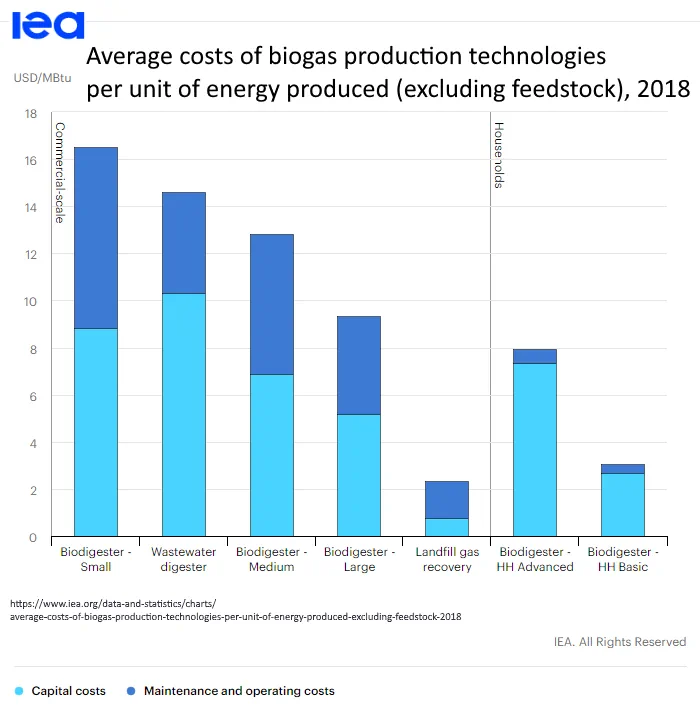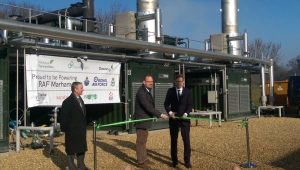The use of biogas power for renewable low carbon dioxide emissions and, with carbon capture, the ability to provide carbon-negative electricity is unique and growing.
In general, the cost of biogas power is slightly higher than the cost of generating electricity from wind or utility-scale solar PV but this is more than offset by the fact that biogas is reliable power. It is always available. Biogas generators run 24/7 and 365 days a year with exemplary uptime and load factors.
Biogas Power No Longer Needs Government Subsidy
In Germany, for example, a guarantee of feed-in prices and subsidies made biogas power plants commercially viable in the early 2000s. In the UK there was ROCs funding for a while which did the same. This kind of financial support was been critical in launching the early biogas plants.
However, elsewhere and without adequate government incentives, biogas power plants were unable to become profitable. That all changed in 2021. That was when shortages of non-renewable fuels due to the recovery of demand, after the covid pandemic, began to raise the market value of energy doubling and even tripling pre-2021 prices.
Biogas Power – The Cheaper Energy Option Since 2021
Since 2021 the cost of traditional (non-renewable fossil-fuel-based) energy has outstripped the cost of biogas production. It is therefore no longer crucial for governments to provide support to promote feed-in schemes and other incentives. However, many EU countries, for example, have introduced incentive schemes since 2021 in recognition of the non-energy benefits of biogas production. In 2022, we have also seen incentivisation of biogas production in order to produce biomethane as a replacement for Russian natural gas supplies.

Upgrade your Biogas Power to Avoid Corrosion
Biogas fuel is widely available and is compatible with most engines. Its availability makes it feasible to use biogas in engines that produce up to 500 mW. Engines that can cope with biogas fuels typically do not contain metal, which is prone to corrosion from sulphur-rich fuels. To avoid corrosion, biogas fuel should be purified (upgraded) to biomethane which is free of sulphur and siloxanes. Low sulphur content is important to prevent gas engine corrosion. Sulphur is converted to acidic corrosion products during condensation, and a high concentration can damage metal working parts.
Most New Biogas Plants Don't Export Electricity
Biogas is a natural alternative fuel and is a renewable energy resource. It has in the past (until about 2017) primarily been used for:
- electric power generation, and with the lower grade heat output being
- used in home, office, and industry for space-heating via CHP installations, most used in Europe.
But biogas power can also be more sustainably upgraded to biomethane and injected into gas grids as renewable Compressed Natural Gas (rCNG). It can also be used as a vehicle fuel with lower distribution energy losses than in electricity generation and distribution.
Biogas Cogeneration Power
Cogeneration is the practice of capturing the process heat of biogas production in CHP projects to heat flats and offices, while primarily using it for electricity generation. By using heat exchange units, cogeneration can produce electricity from waste and simultaneously provide additional sustainability by using this otherwise waste-heat to heat district heating systems.
Biogas Power Injection into the Natural Gas Grid
Biogas can be produced at both industrial and household levels and is capable of being compressed to natural gas standards for injection into the natural gas grid. It can also be used as a gaseous biofuel in gas engine-based captive fleets.
Animal dung and sewage are both good biogas power candidates for their conversion to biomethane. Small-scale digesters can feed into larger digesters. This makes biogas power very affordable and environmentally friendly.
The Biogas Fuel Cell
Biogas can also be converted to electricity using a fuel cell. However, this method requires very clean gas and expensive fuel cells. Therefore, it is not a feasible option for most consumers. A more practical option is to convert biogas to electricity using a generator set. Biogas is highly knock-resistant and can be used in combustion motors with high compression rates.
The technology of biogas power for electricity generation is similar to that of natural gas, with some major differences. Both biogas and natural gas are natural gases with high methane content. Natural gas contains 80 to 90% methane. The methane content is responsible for the energy content in the gas. The sulphur content must be minimized when fueling engines. Typically, one m3 of biogas is equivalent to 0.5-0.6 l of diesel fuel. This means that biogas can be used as an alternative fuel for vehicles and generators.
Carbon Neutral Biogas
Biogas is an environmentally-friendly form of energy. It is carbon neutral, meaning that the carbon dioxide produced when biofuel is burned has already been removed from the atmosphere during its lifetime. Biogas is also a renewable resource. In some countries, it has the potential to replace up to 17% of vehicle fuel. Biogas also has the potential to be upgraded to bio-methane, which is the equivalent of natural gas.
Carbon Negative Biogas
To be carbon negative in a process it has to be shown that more climate-changing gas is removed by the process overall than if the biogas system was not in use.
Since 2017 most biogas power has been used as a fuel for vehicles for reasons of efficiency of use. About 1/3 of the energy produced as electricity is lost before it arrives at its destination. Click here to read about biomethane power.
Now read on for our case study on biogas power generation below:
Biogas power will generate Green Electricity for a Norfolk Military Base it has been announced. The UK Anaerobic Digestion Plant will the first to be used in this way. It will see almost all of the bases electricity requirements supplied from a new on-farm green renewable energy resource now operating.
Press Release Starts (Winter 2019) Starts:
Biogas Power to Make Green Electricity for Norfolk Military Base UK AD Plant
Defence Minister extols virtues of anaerobic digestion [and Green Electricity] following military base deal
- Minister Tobias Ellwood calls anaerobic digestion “a truly green and sustainable solution”
- Norfolk AD plant to supply renewable electricity to nearby RAF Marham military base
- The AD trade body says the deal “demonstrates the value of AD in tackling climate change”

Minister for Defence People & Veterans Tobias Ellwood MP has described anaerobic digestion (AD) as “a truly green and sustainable solution” as he launched a new deal that will see a Norfolk military base receive almost all its power from a nearby AD plant.
Future Biogas’s Redstow Renewables AD plant, which converts locally harvested crops such as maize, sugar beet, rye, and potatoes into renewable electricity (in the form of biogas) and natural fertilizer, will meet over 95% of the power needs of nearby RAF Marham. The base will be the first in the UK to run almost entirely on green electricity.
The AD plant will generate 4.5 megavolt amperes of electricity every day, enough to power 350,000 LED bulbs. The deal will save the Ministry of Defence nearly £300,000 every year and reduce its carbon emissions by 14,000 tonnes of CO2 annually. The waste residue from the AD process will also be dried and used as fertilizer to help grow local crops.
Mr Ellwood said:
“RAF Marham is leading the way as Britain’s first green military airbase. The biogas fuel is a truly green and sustainable solution, helping us tackle climate change, support the local economy and save taxpayer money.
“I hope that this plant can act as a model and we can see more sustainable energy schemes rolled out across other military bases.”
Philipp Lukas, Managing Director at Future Biogas, said:
“It’s fantastic to see the UK military join the green revolution. If we are to combat the imminent global threat of climate change, everyone, from all walks of life, needs to transition to renewable, sustainable energy as quickly as possible.
“The AD plant in Swaffham now powers a significant local institution. In doing so, it not only helps secure the energy supply of a strategic national asset, but also takes the pressure off the local electrical infrastructure, which has been really struggling to keep up with growing regional demand.”
Jon Harrison, External Affairs Manager at the Anaerobic Digestion & Bioresources Association, the UK’s trade body for AD, said:
“This pioneering deal demonstrates the enormous value that AD offers in producing home-grown, renewable energy that is increasing the UK’s energy security and helping to tackle climate change.
“It’s great to see yet another minister extolling the many virtues of AD – what we now need from government is long-term support for AD to ensure we see lots more good-news stories like this in the future.”
PR ENDS
Other News About Biogas Power to Make Green Electricity for Norfolk Military Base
Electricity will be fuelled by fermented locally grown crops, providing 95% of RAF Marham's energy needs and saving the MOD nearly £300,000 every year.
The facility, built by Future Biogas, will generate 4.5 MVA of electricity every day, which can power 350,000 LED bulbs. This project has been delivered by the Defence Infrastructure Organisation (DIO) with government and private sector colleagues.
RAF Marham is leading the way as Britain's first green military airbase. The biogas fuel is a truly green and sustainable solution, helping us tackle climate change, support the local economy and save taxpayer money. via www.gov.uk
Future Biogas has announced that an anaerobic digestion plant is to be built and ran by the company to power over 95% of the RAF Marham military base in Norfolk.
The green energy partnership signals the UK military’s transition away from using fossil fuels as the Norfolk AD plant will be one of the first to power a military base. The plant will be fuelled by locally grown crops. via www.bioenergy-news.com
In the United Kingdom (UK), the Royal Air Force (RAF) Marham, the home of the UK's F-35 multi-role combat jets, is set to become the first military airbase to be powered by green electricity. Defence Minister Tobias Ellwood made the announcement on January 31, 2019, during a visit to a Norfolk biogas plant, where he officially opened the new site that will provide energy to the airbase.
On January 31, 2019, Tobias Ellwood MP opened a new biogas facility which will power the RAF Marham airbase in the UK (photo courtesy Ministry of Defence). via bioenergyinternational.com
Recently Opened US Army Biogas Plants Also Exist
Although it was a “first” for the UK, the US Army has been using biogas for some time.
BioConversion Solutions' (BCS) has an Advanced Fluidized Co-Digestion & Co-Generation (AFC2) anaerobic technology that can be used on military bases to provide [what they describe as] the world's highest conversion rate to biogas for power generation using the base municipal wastewater and food waste as feedstocks.
They state that their proven and proprietary AFC2 process greatly improves the security of fuel supplies and energy self-sufficiency for the United States and other military agencies.
Military installations of the AFC2 process often have the opportunity to share sites and facilities with host communities to defray infrastructure and operating costs as well as to increase the scale of the biomass-to-energy plant.
Military bases may also engage in Public-Private Partnerships where access is provided to base-produced feedstock, land for the plant, and long-term power purchase agreements for a privately financed, owned and operated biomass-to-energy plant. via www.bioconversionsolutions.com
In September 2018, the US Cape Cod Military Base also went renewable (100%) after it was integrated with the Otis Microgrid project based on renewable energy. Experts believe that if the US military bases were allowed to develop their full potential to produce green energy, they would be significantly more secure. US armed forces, unlike the US administration, have nearly doubled their Renewable Power generation between 2011-2016, as according to them they understand that national security and energy security are entwined.
Green Electricity from Biogas Power for the Military – Case Study Conclusion
A landmark partnership was celebrated yesterday with a power “switch on” event at Redstow Renewables, in Swaffham. The Minister for Defence People & Veterans Tobias Ellwood MP was the guest of honour.
“Britain has a proud history of pioneering ways of promoting and using green energy. The armed forces obviously have an obligation to defend our shores and interests, but we must conduct those responsibilities with a wider interest in the world around us. The UK armed forces own three per cent of UK land, which is a big part of the national real estate. We need to look at how can we create more biogas energy.
It's fantastic to see the UK military join the green revolution. If we are to combat the imminent global threat of climate change, everyone, from all walks of life, needs to transition to renewable, sustainable energy as quickly as possible. The AD plant in Swaffham now powers a significant local institution. via www.futurebiogas.com
[First published February 2019.]




